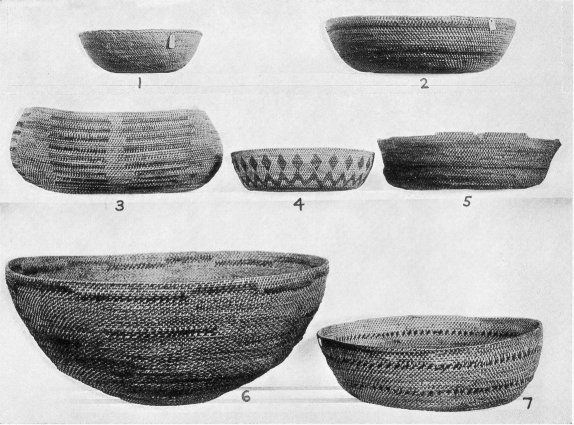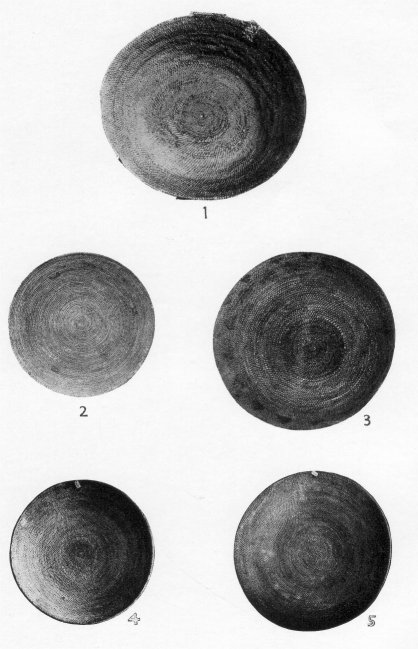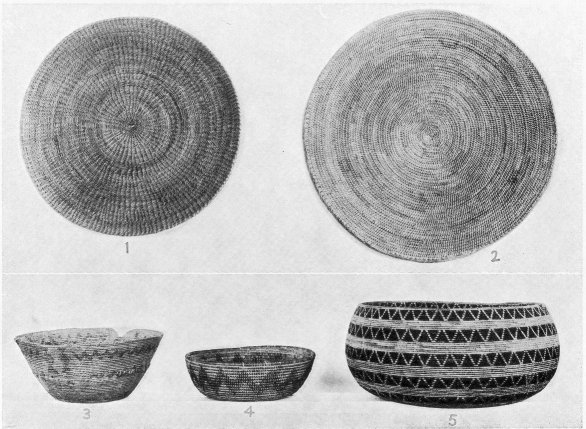
[click to enlarge]
| Online Library: | Title | Author | California | Geology | History | Indians | Muir | Mountaineering | Nature | Management |
Yosemite > Library > Miwok Material Culture > Coiled Baskets >
Next: Techniques • Contents • Previous: Cradles
The foundation rods (tcu'lüme, N; sa'pu, C) of coiled baskets were gathered when the plants were in their prime, and were stored in bundles or coils for use during the remainder of the year. For certain coiled baskets, rods ten feet long were used. Some baskets were coiled clockwise, others contra-clockwise.
In the discussion of materials the Field Museum specimens are combined with the University’s. The identification of plant materials in the former collection was by Dr. J. W. Hudson, in the latter by Miss Ruth Earl Merrill.
For foundation materials 59 coiled baskets had Salix, 33 Epicampes rigens californica, 20 Rhus trilobata, 7 Prunus demissa, 4 Corylus rostrata californica, 4 Avena, 3 Cornus glabra, 1 Cercis occidentalis, 1 Pinus ponderosa root. The last also had the same material for wrapping. Informants mentioned, as also used for foundation, Lonicera hispidula (pipenu, C) stems and a grass (cū'lupü, lī'ma, N; sū'lpanû, C; hū'lūp, S). Perhaps this grass is Epicampes rigens.
The Northern Miwok use Epicampes grass less frequently for foundations than do the Central and Southern Miwok. It occurs as foundation in 4 Northern, 17 Central, and 10 Southern baskets. The adjacent Maidu on the north do not employ the plant for basketry even though it grows in their territory. 91 The Washo, however, use it. Hazel is another material used scantily by the Miwok, but not at all by the Maidu.92
For wrapping or sewing materials the following were noted: Cercis occidentalis sapwood in 73 baskets, Carex barbarae (sū'lī, P, N, C; pa'iwa, S) root in 21, Rhus trilobata in 13, Acer macrophyllum (sayi, C) sapwood in 8, Pinus ponderosa rootlet in 4, Carex robusta in 3, and Cyperus virens in 1.
The Miwok of the Upper Sonoran life zone used the slender twigs of the digger pine as white sewing material. The twigs were gathered in the spring when the bark slips off easily. They were hacked off with a sharp stone flake (tepelila, C), sometimes even of granite, not a knife. The inner woody portion was split into four sections. The splitting was begun at the outer or small end of the twig, the outer end of the twig being bitten in half longitudinally. Then one-half of the split end was held between the teeth, while the fingers carefully guided the splitting for the full length. The unsplit portion was held rather tightly between the right thumb and forefinger. With the left hand the loose half was pulled downward. Simultaneously the right hand was slid downward, so that the splitting took place just above the right thumb and forefinger which guided the course of the splitting, while the left hand furnished the motive power. Thereafter the two halves were similarly split into quarters. The pith was removed from each quarter by biting it free at the small end first. The woody portion was then held in the teeth and the separation of pith and wood continued for the length of the quarter with the fingers. Sugar pine twigs were too brittle for use; no part of the sugar pine was used for basketry.
Slough grass (Carex barbarae) root yielded a fine white material, usually found in the finer baskets, and used especially by the lowlanders, in whose territory this plant abounded. The mountaineers often used other and coarser white elements because of the scarcity of the slough grass in their country. The roots of the slough grass are brown externally and about three-sixteenths of an inch in diameter. The roots were split to obtain the white material within. The sapwood of the maple (Acer macrophyllum) was obtained only in spring when the bark slips off readily. The shoots were too tough to be broken off by hand and were cut off with a sharp fragment of stone, unworked. They were then scraped with a flake of gray stone called kolubu (C).
The redbud bark for patterns was obtained to best advantage after the sap had begun to run. The outer bark yielded a red, decorative material, which was used particularly in the mountains.
Three brown or black elements were employed. (1) Fern (Pellaea mucronata), kepekü (C), roots, sometimes twenty feet long, were dug for the brown covering which was stripped off. The roots were usually dug from a vertical bank where removal was easy. (2) Bracken (Pteris aquilina), sī'na (P, N, C), ta'tama (P, N), roots were most used for brown and black patterns. (3) The third plant, the root of which yielded a brown material (mu’lla, C, S), was not identified. These materials were brownish when taken from the plants. They were dyed black by placing them in warm ashes, dyeing with green manzanita charcoal pulverized in warm water, boiling in certain mud, or in water with fresh black oak bark. In the Field Museum and in the University’s museum there are forty-six coiled baskets with designs in redbud and seventy with designs in bracken. Of the latter in the University’s collection five had the material mud-dyed and one manzanita charcoal dyed.
Feathers were said to have been formerly employed for fine basketry decoration. Red feathers were obtained from the California Woodpecker (Melanerpes formicivorus), paltī'na (P), pala'tata (N, C, S); the Pileated Woodpecker (Hylotomus pileatus), pa'kpaku (C); and the Red-winged Blackbird (Agelaius phoeniceus), tcīkūppa'tī (P). The Mallard (Anas platyrhynchos), sīnahī'ka (P), hī'kasü (N), yielded green feathers, the Meadowlark (Sturnella neglecta), yū'kū'lī (P), pī‘'na (N), yellow feathers; and the Brewer’s Blackbird (Euphagus cyanocephalus) black feathers. The plumes from the crests of the Valley Quail (Lophortyx californica) and the Mountain Quail (Oreortyx pitta) were also used.
These various materials were manipulated and woven with the hands. The only tool was the bone awl, which was used to pierce the finished part of the basket, to make an opening through which to pass the sewing material. A series of these awls is shown in plate XXXIX.
The starting knot (sayu, C) in many coiled baskets is a small, tightly bound coil of fine maple or sedge splints, or of the leaf of Iris hartwegii (yotowina, C). These must be very fine to permit bending at a very sharp curve. Such a special starting knot is unnecessary in the multiple-grass foundation basket, since the grass, when wet, is very pliable.
The border of a coiled basket was often left with only the finish of the last round of sewing (plate XLVIII, fig. 6). A more careful finish was plain whipping over or sewing of the edge (plate XL). An ornamental edge was furnished by a similar, but diagonal whipping (plate XLIX, fig. 4, and plate L, fig. 2); and a more ornamental finish was formed by two opposing diagonal sewings which formed a herringbone design. All these border finishes were called tū’llī and mumbilo (C).
———
91Merrill, map 6.
92Merrill, map 3.

[click to enlarge] |
Coiled baskets of single-rod technique.
Figure 1. Dipper Basket. Spec. No. 1-9911 ( N ). Neg. No. 4972. Diameter at rim 201 mm.
Figure 2. Parching basket. Spec. No. 1-10261 (S). Neg. No. 4972.
Figure 3. Elliptical or canoe-shaped basket. Spec. No. 1-10153 (C). Neg. No. 4877. Diameter at rim 416 mm.
Figures 4, 5. Basket used for serving food and as general receptacles. Spec. Nos. 1-10203 (C), 1-10158 (C). Neg. No. 4877.
Figure 6. Hemispherical basket. Spec. No. 1-10107 (C). Neg. No. 4877.
Figure 7. Basket used as a general receptacle and for serving food. Spec. No. 1-10152 (C). Neg. No. 4877.

[click to enlarge] |
Coiled plate-form baskets of single-rod technique.
Figure 1. Basket used for parching seeds and other foods. Height 71 mm. Spec. No. 1-9910 (N). Neg. No. 5977.
Figures 2, 3. Winnowing baskets for acorn meal. Spec. Nos. 1-9936 (N), 1-10088 (C). Neg. No. 4967. No. 2, diameter at rim 386 mm.
Figures 4, 5. Winnowing baskets for acorn meal. Spec. Nos. 1-9901 (N), 1-10089 (C). Neg. No. 4971. No. 4, height 66 mm.
Coiled baskets of multiple-grass foundation.
Figure 1. Plate-form winnowing basket. Spec. No. 1-10155 (C). Neg. No. 8270.
Figure 2. Plate-form winnowing basket with herringbone border finish. Diameter 390 mm. Spec. No. 1-9936 (N). Neg. No. 8270.
Figures 3, 4. Dipper baskets. Spec. Nos. 1-10189 (C), 1-10260 (S). Neg. No. 8968. No. 3, height 111 mm.
Figure 5. Finely woven, globose basket. Spec. No. 1-10289 (C). Neg. No. 8968.

[click to enlarge] |
Next: Techniques • Contents • Previous: Cradles
| Online Library: | Title | Author | California | Geology | History | Indians | Muir | Mountaineering | Nature | Management |
http://www.yosemite.ca.us/library/miwok_material_culture/coiled_baskets.html